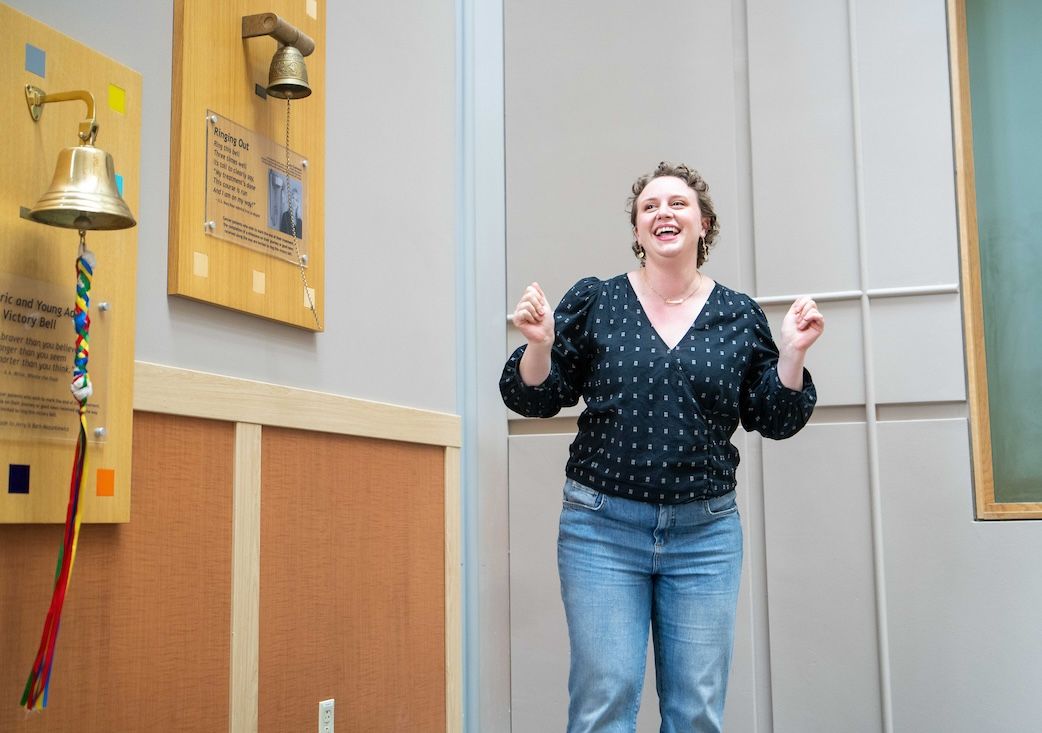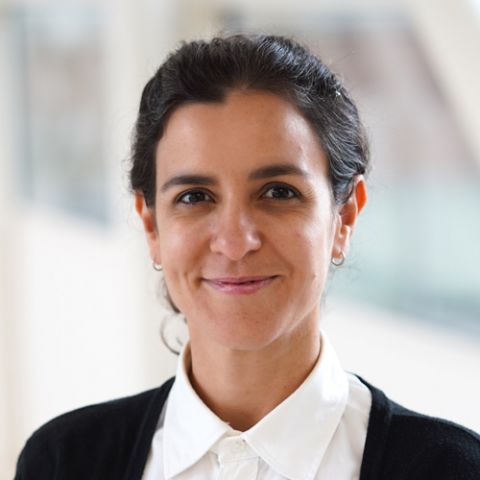Choosing immediate reconstruction was part of her treatment plan to reclaim her health
For Hannah Bronstein, now 33, it began in spring 2024 when she felt a golf ball-sized lump in her left breast. “By the next week I was at Roswell Park, where I had the first — and what would turn out to be the only — mammogram of my life, followed by a biopsy."
Hannah soon learned she had stage 1 triple negative breast cancer, an aggressive type of breast cancer that means treatment usually needs to start soon. Hannah's doctors at Roswell Park Comprehensive Cancer Center, surgical oncologist Jessica Young, MD, FACS and medical oncologist Varsha Gupta, MD, had already mapped out her treatment plan: 16 chemotherapy and immunotherapy infusions before surgery to shrink the tumor, then surgery (a lumpectomy or a mastectomy), followed by additional immunotherapy and possibly radiation.
The first major decision: fertility preservation
Because chemotherapy and radiation can damage fertility, Hannah met with Denise Rokitka, MD, MPH, Director of Roswell Park’s Oncofertility and Young Adult program. “I hope to have children someday, so I opted to have my eggs harvested, frozen and stored before starting treatment. I had hormone injections to stimulate egg production and soon felt like there were water balloons in my belly. Three weeks later, 18 of my eggs were successfully harvested and stored.”
Connecting with other young adult patients
Before and during chemotherapy, Hannah also took the opportunity to learn from other “breasties” through two Roswell Park programs: a nurse-facilitated support group for breast cancer patients under age 50, and Roswell Park’s Young Adult program, which includes social events, retreats, speakers and more to help young adult patients connect with peers.
“I went to Roswell Park’s ‘Cancerchella’ event right before I started chemotherapy, and while I was a bit overwhelmed, all the information I received helped me feel more prepared for my upcoming treatment,” Hannah says. “It also helped me see that people do get to the other side of treatment and can begin focusing on their future again.”
Evaluating lumpectomy versus mastectomy
Once treatment started, Hannah had to choose between having a lumpectomy or a partial or total mastectomy. “From the start, Dr. Young advised having a double mastectomy after I completed chemotherapy, to reduce my risk of cancer returning.” Hannah also solicited advice from some of her support group breasties. “Because TNBC is aggressive and has high recurrence rates compared to other breast cancer types, many women opted for double mastectomy while others went with a lumpectomy,” Hannah says.
“My decision to have a double mastectomy was solidified midway through chemotherapy, when genetic testing revealed that I had the BRCA1 gene mutation. Lifetime survival rates for triple negative cancer are about the same whether you have a mastectomy or lumpectomy, but when you factor in the BRCA risk of a new cancer, a mastectomy is recommended. As much as I didn't want to lose my natural breasts, I also didn't want to risk going through cancer treatment again if I could help it!”
Hannah’s immediate family members subsequently had genetic testing. “We learned that my father is also BRCA1 positive, which may increase his risk for male breast cancer and prostate cancer,” Hannah says. “So, ironically, since I’ve had a double mastectomy, I will never have another mammogram, while my father will have mammograms on a regular basis.”
Why choose Roswell Park for breast cancer treatment?
We offer both a wide range of treatment options, as well as support services, to care for both you and your cancer.
The mastectomy and reconstruction experience
After completing chemotherapy and pre-surgery immunotherapy, Hannah had her surgical pre-op appointment with Dr. Young and Cemile Nurdan Ozturk, MD, Department of Head & Neck and Plastic & Reconstructive Surgery at Roswell Park and decided on breast reconstruction with implants “to help restore my body to its more natural appearance.” In an attempt to de-stress on the way home, Hannah and her mom stopped at the SPCA ‘just to look.’ "We ended up coming home with a rescue dog!” Hannah laughs.
That fall, Dr. Young performed a three-hour surgery to remove both of Hannah’s breasts, and then Dr. Ozturk placed tissue expanders in Hannah’s chest to slowly stretch the skin in preparation for the implants. "The great news after that was that the mastectomy pathology results revealed a pathological complete response, or PCR, meaning my cancer was responsive to treatment, the chemotherapy had worked and I had no signs of any active cancer remaining. I then had nine more rounds of immunotherapy. I also went to physical therapy clinic post-mastectomy for lymphedema monitoring.”
Over the next two months, Dr. Ozturk continued to stretch the expanders, filling them with air the first month and saline the second month. “The expanders can be uncomfortable,” Hannah recalls. “I could feel their hard edges and they are weirdly square shaped. I didn't like how they looked or felt.” In March, Dr. Ozturk completed Hannah’s reconstruction surgery and swapped the expanders for implants. “Fat suctioned from my abdomen was placed on top of the implants to create more natural appearance, including cleavage, and to hide ‘rippling’ from the effects of gravity on the implants.
“The reconstruction surgery was less painful than the mastectomy,” Hannah adds. "But I needed to wear an abdominal compression garment for a month post-surgery. The spanx I bought initially had shorts attached which made them difficult to get on and off to use the bathroom, which got old FAST. I eventually found a random $25 waist compression garment online that worked better. I also wear compression bras when working out to prevent lymph swelling and implant movement.”
Adapting to her new normal
“I’m still trying to get used to the new shape of my body and how the implants look when I’m not wearing a bra,” Hannah says. “I’ve lost my hourglass figure. My breasts used be DD sized, but the implants are about a C cup; they can’t be much bigger because they are heavier than natural breast tissue and could move. I may eventually get nipple tattoos for added realism.
“I am irritated with the weight I've gained — caused in part by steroids from chemotherapy, and hypothyroidism, a side effect of immunotherapy, which also accounts for my low energy levels and difficulty losing weight. But I am working out at the gym and that has helped me both physically and mentally.
“Re-entering the dating world and wondering how a future partner may perceive my body makes me nervous, but I am trying to be gentle with myself and am working on this in therapy. I know the preservation of my life and health is way more important than how my body looks, but it’s difficult to get past such internalized beauty standards.
“Overall the breast reconstruction has helped my self-esteem,” Hannah concludes. “With a bra and clothes on, my proportions look balanced and make me feel a little more ‘normal.’ Only I know that my breasts are smaller and less wonderful than my natural breasts were, but they are also less dangerous. I do not regret my decision to have the cancerous breasts removed and replaced with something that allows me to go about my life with less fear and relative normalcy.”
Editor’s Note: Cancer patient outcomes and experiences may vary, even for those with the same type of cancer. An individual patient’s story should not be used as a prediction of how another patient will respond to treatment. Roswell Park is transparent about the survival rates of our patients as compared to national standards, and provides this information, when available, within the cancer type sections of this website.




